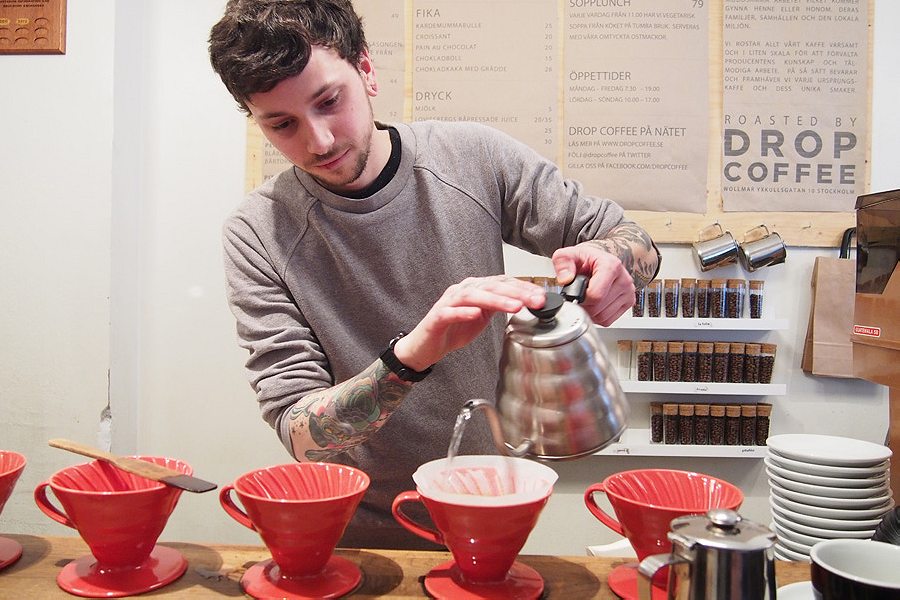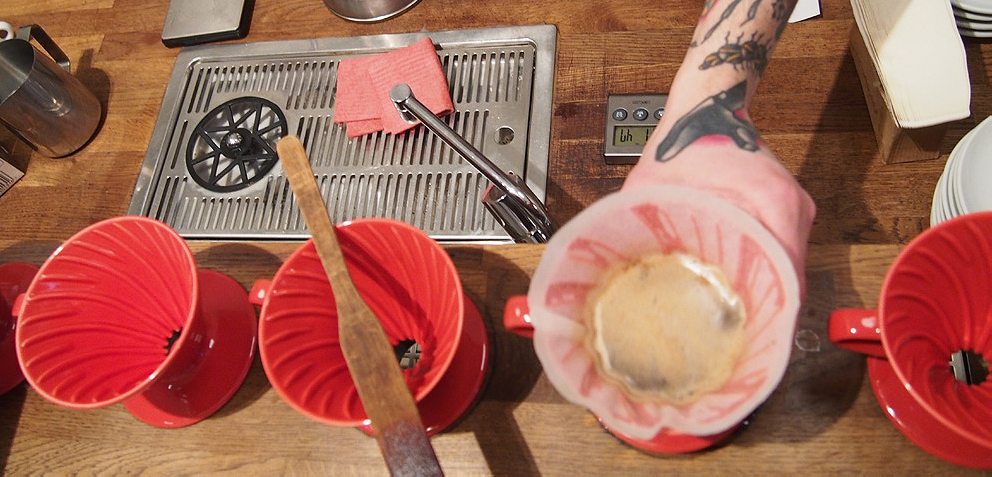The modern coffee movement, as seen through a small café in Stockholm.
I don’t need you to tell me how fucking good my coffee is, okay? I’m the one who buys it. I know how good it is. When Bonnie goes shopping she buys SHIT. I buy the gourmet expensive stuff because when I drink it I want to taste it. —Jimmie Dimmick, Pulp Fiction (1994)
No doubt Jimmie meant every word he told those two blood-soaked gangsters standing in his living room at daybreak, sipping their mugs of tasty java, but Jimmy’s idea of quality coffee wouldn’t satisfy even the least-dogmatic coffeehound these days. Did the beans come from a single farm, preferably in the sweatiest part of Honduras or Ethiopia? Did he use a burr grinder to whiz the beans into perfect particles no more than 60 seconds before brewing? Did he weigh the coffee and the water and make sure the proportions were just right? Did he brew individual cups for Jules and Vincent in an AeroPress? Or at least a Chemex? Well, then by today’s standards, Jimmie don’t know shit about the gourmet expensive stuff.
For the first thousand or so years, a cup of coffee was, for the most part, a cup of coffee, ground whenever convenient, brewed however possible, consumed more for the energy it imbued than the subtle flavors it gave off. Sufi monks, some of the earliest coffee drinkers, used the magic brew to stay alert during long religious ceremonies.
By the 17th century, coffee had begun to make its way from northern Africa and the Middle East to the western world, first through trade to Venetian merchants, and later to the Americas, where a little brouhaha in the Boston harbor helped turned coffee into the drink of choice for the colonists. Despite some light resistance (opponents called this strange brew “the bitter invention of Satan”), coffee flourished in Europe and the New World as coffeehouses soon became centers of social interaction and political discourse. In the three hundred years since, it’s the West that has been responsible for most of its important innovations, the good (precision grinders), the bad (freeze-dried industrial grounds), and the debatable (Starbucks, pod coffee).
Among the earliest western innovations was espresso, a dense distillation of extracted coffee particles that would go on to change the way much of the world gets their caffeine fix. It wasn’t just the intensity of the beverage itself, but the café culture it spawned. Suddenly a brave new world of caffeinated options appeared on menus, and brewed coffee took a backseat to all the grinding, tamping, and steaming required by the mechanized extraction and its many milky iterations. In this new era, the man behind the bar wasn’t just a faceless peddler of muddy water, but a craftsman, one whose skill was both highly visible and immediately discernible. Thus began the age of the barista.
But espresso had its limits, the coffee nerds eventually discovered, not the least of which was the legion of soccer moms and dilettante dads ordering skinny mocha pumpkin soy lattes covered in cinnamon snow. By the time the 21st century arrived, the purity of the craft had been drowned out by seventeen-syllable drink orders. The response was as prosaic as it was potent: black coffee.
[Trigger warning: if you are angered by people who are deadly serious about their coffee, if hearing them talk unironically about how to make the best single cup of coffee on the planet would send you into a rage, stop reading now. Take a look instead at our less-geeked coffee stories—our mini-documentary on the delightful Department of Coffee in Cape Town, perhaps? However, if you care deeply about coffee, or even are curious about what combination of beans and roasting and water would make others care as deeply as they do, then please, by all means, keep reading.]

If you lived in Sweden, you would drink a lot of coffee, too. In fact, if you lived there during the winter months—when the sun rises around the time you’re sitting down for lunch and sets before you have time to pay the bill—it’s unlikely you’d ever leave the café. You’d have no shortage of places to chose from: the coffeeshop density in Stockholm could rival that of Seattle, Rome or Amsterdam. It’s a place where even bad coffee tastes like a lifeline. Which makes the fact that there are serious coffee people doing serious coffee things in this country all the more impressive.
Drop Coffee is more than just a serious place serving serious coffee. It’s a place that applies a sort of religious piety to the beverage. On the walls you’ll find awards from barista championships, displays of the latest in pourover brew technology, bags of house-roasted beans from tiny farms in places far far away.
At Drop, you can order a latte with art etched into its foamy cap, or an espresso dense and syrupy with notes of wild blueberry. And if you do, you will no doubt be deeply satisfied. But Drop, like most of the serious coffee houses of the world, carries just one type of espresso, focusing most of its energies instead on an extensive and revolving menu of single-origin beans brewed individually to order.
Translation: If you want to taste the caffeine revolution, you’ll need to order that coffee black.
Consider the excruciating path from tree to cup: Drop sources its beans from Central America and Africa, mostly from small farms selling very high-quality fruit for top dollar to a handful of roasters around the world. Once in house, the beans are roasted in a 15-kg Giesen machine for between 13 and 16 minutes.
The roasted beans are measured out in 18-gram portions, then placed whole in little spice bottles and stacked on a shelf behind the baristas. On a given day, you can order from up to eight different single-origin beans, ranging from $6 to $15 for a small pot. When a customer orders a coffee—say, Perci from Panama or Kangocho from Kenya—the beans are ground in a Mahlkonig Guatemala grinder, then measured again on a scale just to make sure. The water, 300 grams of it (“we like a 16.6 to 1 ratio”) is also weighed on a scale.
The coffee goes into a V60, a simple ceramic cone that has become the go-to method for serious baristas in recent years, and a timer is set. Water is added in 75-gram intervals, poured out in tight circles over the course of two-and-a-half minutes—all the better for getting the most even extraction out of the grounds. “Give the coffee some time to cool so you can taste the full bloom,” says Benjamin Norman, a young barista with tattoo sleeves who spends the better part of the afternoon schooling me in the intricate art of pourover brewing.
I do as I’m instructed and wait. Given everything that has gone into this cup, there is a certain pressure not to screw it up. Milk and sugar would be a gross offense to people this precise.
The coffee is from Cerro Azul in Colombia, and as it sits shimmering in my cup, a gentle aroma rises to remind me that what I am about to drink is not like anything I’ve tasted before. The aroma is not of toffee or toasted bread or tobacco, but of red fruit and cut grass. The taste is not stern or brooding, but clean and light, with the bright acidity of a bruised orange peel and a mouthfeel so fickle that the flavor seems to jump right off your tongue as soon as you’ve swallowed.
As Oliver Strand, one of the great chroniclers of modern coffee culture, once wrote about a cup like this: “At first it’s disorienting — the coffee isn’t like any other coffee. Then it’s exciting — the coffee isn’t like any other coffee.”’

Guys like Strand consider Scandinavia to be at the center of the coffee world, with places like Copenhagen’s Coffee Collective and Tim Wendelboe, a three-seat coffee temple in Oslo, inspiring pilgrimages from coffeehounds from around the globe. The unifying ethos behind these Scandinavian satellites is lightness.
There are many ways to interpret the language of a bean, and most of that interpretation comes out in the roasting process: roast beans long and hard until they’re dark and oily and you have a certain extreme expression of coffee, not delicate or nuanced, necessarily, but assertive and impacting. Drop Coffee, like its Nordic neighbors, prefers a lighter hand, roasting the beans several minutes shorter than what most drinkers are accustomed to in order to produce a more delicate, nuanced cup of joe.
This may be the direction of coffee to come, but not everyone is a fan of the light-roast movement. When I tell a well-known chef in northern Sweden about my time at Drop, his eyebrows narrow. “I don’t want my coffee to taste like a strawberry.”
But the high priests of pourover coffee just shrug. “Coffee is just a combination of taste and aromas. My job is to bring the best combination forward,” says Erik Rosendahl, one of the owners of Drop Coffee.
Of course, this type of coffee comes at a cost: not just in the price of the cup and in the earnestness with which it is delivered, but in the fact that to truly be enjoyed, it requires your full participation. You can’t order a cup like this through a window and take it to go. And you sure as hell can’t be burr grinding beans and weighing out water and breaking out the timer when you’ve got a couple of gangsters in your living room with a dead body to dispose of. For guys like that, gourmet expensive stuff might as well be anything that’s not Folgers.

The Path to a Better Cup of Coffee
-Burr Grinders: It’s been said by many a coffee expert that you’d be better off with bad beans and a good grinder than a exceptional coffee and a shitty grinder. A bad grinder (like those cheap whirling-blade grinders most people use) breaks the beans down into particles of all sizes, meaning some will be over-extracted and some will be under-extracted, making for a very uneven cup of coffee. Good grinder means a burr-style grinder, which uses rotating plates to ensure the coffee is ground evenly (and without heating up and compromising the beans’ essential oils).
-Water: “It’s 90% of the drink, yet nobody really thinks about it,” says Drop Coffee barista Benjamin Norman. Before going to the World Barista Finals in South America last year, the team trained with a variety of different waters in order to get the perfect product. You’re looking for a relatively hard water, with a mineral content of at least 150-200 parts per million. Play around with tap, filtered and bottled waters to find what works best in your hood.
-Good beans: Look for suppliers that carefully source their beans and roast them in house. Single origin trumps blends anyday. In the US, Intelligentsia in Chicago, Stumptown in Portland, and Counter Culture in Durham are all world-class roasters.
Not only has it emerged as the most common single-cup brew system in the new coffee universe, but at $15-$20, it’s also the cheapest. The ceramic cone fits right over your mug and allows for a slow, controlled extraction that yields an exceptionally high-quality coffee. All you need is a filter (and, if you really want to get serious, a timer, a scale and a V60 kettle) and you’re ready to brew.